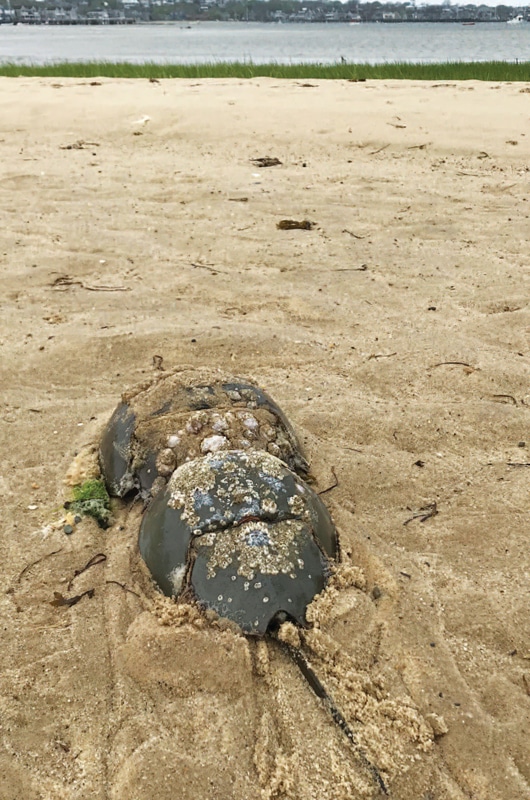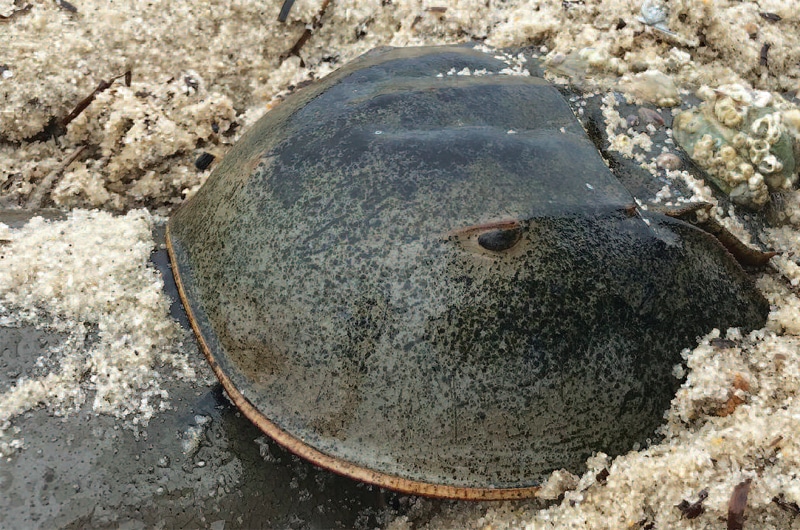Dr. Sarah Treanor Bois
Director of Research & Education at the Linda Loring Nature Foundation
There is a prehistoric creature frolicking among Nantucket beaches right now. If you happen to be at the right place at the right time, you may find yourself among an orgy of living fossils. These are Atlantic Horseshoe Crabs.
Atlantic horseshoe crabs live along the Atlantic coast from the Gulf of Mexico to Maine. They are usually seen around Nantucket waters in May and early June during their breeding season.

Many people have seen horseshoe crabs but do not realize they are looking at one of the oldest animals on the planet. As “living fossils,” horseshoe crab ancestors can be traced back through the geologic record to around 445 million years ago, 200 million years before dinosaurs existed! Horseshoe crabs are actually not true crabs at all, being more closely related to arachnids than to crustaceans.
Horseshoe crabs have changed very little in the last 350 million years. Structure suits function and they are designed perfectly. Their tank-like shell is actually divided into a front shell, a hinged back shell, and a spike-like tail. The tail can be used to flip the animal upright if it is overturned.
When mating, the smaller male crab attaches himself to the top of the larger female’s shell by using his specialized front claws shaped like boxing gloves. The male fertilizes the eggs as the female lays them in a nest in the sand. Some males (often called satellite males) do not attach to females but still have success in fertilizing the female’s eggs as they crowd around the attached pair.
Why are horseshoe crabs so important?
Throughout its range, horseshoe crab eggs are important food sources for migrating shore birds. The Red Knot, in particular, relies on the abun-dance of horseshoe crab eggs in the late spring when migrating northward. One female horseshoe crab can lay over 88,000 eggs! Over time, the migration patterns and timing of many birds have evolved to coincide with the abundant horseshoe crab egg availability.
Crabs, shrimp, and small fish also eat the eggs and small juvenile horseshoe crabs.
Horseshoe crabs have a copper-based blue blood which contains a substance called Limulus Amebocyte Lysate (LAL). This unique factor of their physiology make them extremely important in the biomedical industry. The LAL compound coagulates in the presence of small amounts of bacterial toxins and is used to test for sterility of medical equipment. Anyone who has had an injection, vaccination, or surgery has benefitted from horseshoe crabs. After the crabs are “bled” and some of their blood is collected, the crabs are released back into the wild where they were captured.
Horseshoe crabs are also harvested to be used as bait for whelk and eel (with a state-issued permit). This fishery is managed at the interstate level by the Atlantic States Marine Fisheries Commission (ASMFC). Every year, the Massachusetts Division of Marine Fisheries submits a compliance report on horseshoe crab numbers, including catch information. In 2016, the latest available report online, 52 of 230 horseshoe crab bait permits issued by Marine Fisheries were actively fished. That same year, fishermen reported catching 101,642 crabs for bait. Only four of the 14 biomedical harvest permits were actively fished in 2016. Those catch numbers are confidential, though the animals are returned to the water after “bleeding.”
Recent closures of the horseshoe crab fisheries in New Jersey, New York, and other neighboring states are expected to increase harvest pressure on dwindling populations of Massachusetts horseshoe crabs. As a first response, the state has reduced the annual quota and prohibited harvests around the full moons from late April through June.
What is Nantucket doing to help protect our horseshoe crab populations? It is crucial that state managers have good estimates of the number of horseshoe crabs in Massachusetts before they can set appropriate harvest quotas.
Since 2009, the Nantucket Conservation Foundation (NCF) and the Maria Mitchell Association (MMA) have been consistently surveying two beaches on Nantucket (Warren’s Landing in Madaket Harbor and Monomoy Beach in Nantucket Harbor) to document population sizes of mating horseshoe crabs. This collaborative regional volunteer effort has been spearheaded by the Massachusetts Department of Marine Fisheries to document population trends. Surveys like this are conducted all around New England on the same days and nights each spring. Organizations like MMA and NCF train teams of staff and volunteers to monitor the populations on the selected beaches.
Because there is such a long-term set of data, researchers can use this information to track horseshoe crab populations as they fluctuate over the years. Surveys are done at high tide around the new and full moons from late April to late June. This is the ideal time to survey because the horseshoe crabs are mating and come into shore at high tides to lay eggs. Over the years, island scientists have found that there is typically one survey session with the highest density of crabs. They have also found that crabs are usually seen more at the night surveys and less frequently in the day, although there are still plenty to see if you take a stroll this season!
Horseshoe crabs are best seen on the harbor beaches during high tides. If you see a horseshoe crab on the beach, please let it be. Taking photos is fine, but also be careful to keep dogs and children from disturbing them. After all, they are mating!



